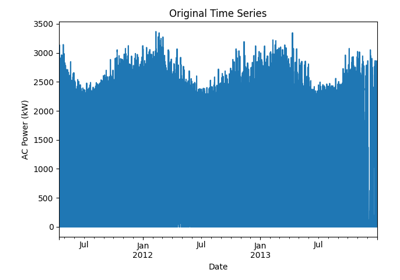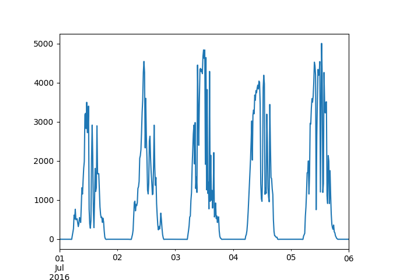pvanalytics.system.infer_orientation_fit_pvwatts#
- pvanalytics.system.infer_orientation_fit_pvwatts(power_ac, ghi, dhi, dni, solar_zenith, solar_azimuth, temperature=25, wind_speed=0, temperature_coefficient=- 0.0047, temperature_model_parameters=None, azimuth_min=0, azimuth_max=360, tilt_min=0, tilt_max=90)#
Get the tilt and azimuth that give PVWatts v5 output that most closely fits the data in power_ac.
Input data power_ac, ghi, dhi, dni should reflect clear-sky conditions.
Uses non-linear least squares to optimize over four free variables to find the values that result in the best fit between power modeled using PVWatts and power_ac. The four free variables are
surface tilt
surface azimuth
the DC capacity of the system
the DC input limit of the inverter.
Of these four parameters, only tilt and azimuth are returned. While, DC capacity and the DC input limit are calculated, their values may not be accurate. While its value is not returned, because the DC input limit is used as a free variable for the optimization process, this function can operate on power_ac data that includes inverter clipping.
All parameters passed as a Series must have the same index and must not contain any undefined values (i.e. NaNs). If any input contains NaNs a ValueError is raised.
- Parameters
power_ac (Series) – AC power from the system in clear sky conditions.
ghi (Series) – Clear sky GHI with same index as power_ac. [W/m^2]
dhi (Series) – Clear sky DHI with same index as power_ac. [W/m^2]
dni (Series) – Clear sky DNI with same index as power_ac. [W/m^2]
solar_zenith (Series) – Solar zenith. [degrees]
solar_azimuth (Series) – Solar azimuth. [degrees]
temperature (float or Series, default 25) – Air temperature at which to model the hypothetical system. If a float then a constant temperature is used. If a Series, must have the same index as power_ac. [C]
wind_speed (float or Series, default 0) – Wind speed. If a float then a constant wind speed is used. If a Series, must have the same index as power_ac. [m/s]
temperature_coefficient (float, default -0.004) – Temperature coefficient of DC power. [1/C]
temperature_model_parameters (dict, optional) – Parameters fot the cell temperature model. If not specified
pvlib.temperature.TEMPERATURE_MODEL_PARAMETERS['sapm'][ 'open_rack_glass_glass']is used. Seepvlib.temperature.sapm_cell()for more information.azimuth_min (Float, default 0) – Minimum possible azimuth (bounds) for the least squares search problem. [degrees]
azimuth_max (Float, default 360) – Maximum possible azimuth (bounds) for the least squares search problem. [degrees]
tilt_min (Float, default 0) – Minimum possible tilt (bounds) for the least squares search problem. [degrees]
tilt_max (Float, default 90) – Maximum possible tilt (bounds) for the least squares search problem. [degrees]
- Returns
surface_tilt (float) – Tilt of the array. [degrees]
surface_azimuth (float) – Azimuth of the array. [degrees]
r_squared (float) – \(r^2\) value for the fit at the returned orientation.
- Raises
ValueError – If any input passed as a Series contains undefined values (i.e. NaNs).
Notes
To prevent significant slowdown, this function uses the SAPM thermal model (
sapm_cell()) instead of the model specified in the PVWatts v5 reference 1 (fuentes()).References
- 1
Aron Dobos, “PVWatts Version 5 Manual”, NREL/TP-6A20-62641 (2014). DOI: 10.2172/1158421

